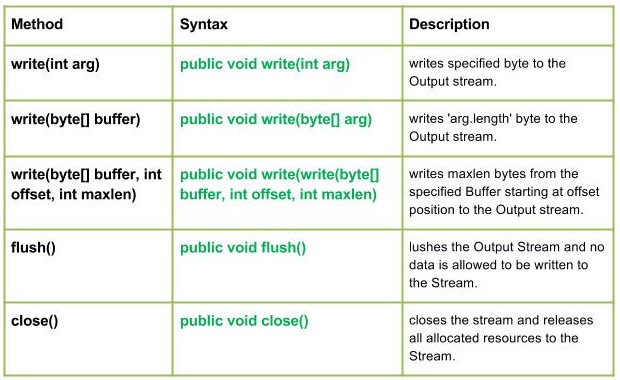Java 中的 java.io.FilterInputStream 类

Java.io.FilterOutputStream 类是所有过滤输出流的类的超类。 FilterOutputStream 类的 write() 方法过滤数据并将其写入底层流,过滤的完成取决于流。
宣言:
public class FilterOutputStream extends OutputStream
构造函数:
- FilterOutputStream(输出流极客):创建输出流过滤器。
方法:
- 写(int arg):java.io.FilterOutputStream.write(int arg)将指定字节写入输出流。
句法:
public void write(int arg) Parameters : arg : Source Bytes Return : void Exception : In case any I/O error occurs.
- Implementation :
Java
// Java program illustrating the working of work(int arg)
// method
import java.io.*;
import java.lang.*;
public class NewClass
{
public static void main(String[] args) throws IOException
{
// OutputStream, FileInputStream & FilterOutputStream
// initially null
OutputStream geek_out = null;
FilterOutputStream geek_filter = null;
// FileInputStream used here
FileInputStream geekinput = null;
char c;
int a;
try
{
// create output streams
geek_out = new FileOutputStream("GEEKS.txt");
geek_filter = new FilterOutputStream(geek_out);
// write(int arg) : Used to write 'M' in the file
// - "ABC.txt"
geek_filter.write(77);
// Flushes the Output Stream
geek_filter.flush();
// Creating Input Stream
geekinput = new FileInputStream("GEEKS.txt");
// read() method of FileInputStream :
// reading the bytes and converting next bytes to int
a = geekinput.read();
/* Since, read() converts bytes to int, so we
convert int to char for our program output*/
c = (char)a;
// print character
System.out.println("Character written by" +
" FilterOutputStream : " + c);
}
catch(IOException except)
{
// if any I/O error occurs
System.out.print("Write Not working properly");
}
finally{
// releases any system resources associated with
// the stream
if (geek_out != null)
geek_out.close();
if (geek_filter != null)
geek_filter.close();
}
}
}- 笔记:
在我使用过的程序中GEEKS.txt文件时,程序将创建一个具有代码中给定名称的新文件并写入其中。
输出:
Character written by FilterOutputStream : M
- write(byte[] buffer): java.io.FilterOutputStream.write(byte[] buffer)写‘arg.length’字节到输出流。
句法:
public void write(byte[] arg) Parameters : buffer : Source Buffer to be written to the Output Stream Return : void Exception : In case any I/O error occurs.
- Implementation :
Java
// Java program illustrating the working of work(byte
// buffer) method
import java.io.*;
import java.lang.*;
public class NewClass
{
public static void main(String[] args) throws IOException
{
// OutputStream, FileInputStream & FilterOutputStream
// initially null
OutputStream geek_out = null;
FilterOutputStream geek_filter = null;
// FileInputStream used here
FileInputStream geekinput = null;
byte[] buffer = {77, 79, 72, 73, 84};
char c;
int a;
try
{
// create output streams
geek_out = new FileOutputStream("ABC.txt");
geek_filter = new FilterOutputStream(geek_out);
// writes buffer to the output stream
geek_filter.write(buffer);
// forces byte contents to written out to the stream
geek_filter.flush();
// create input streams
geekinput = new FileInputStream("ABC.txt");
while ((a=geekinput.read())!=-1)
{
// converts integer to the character
c = (char)a;
// prints
System.out.print(c);
}
}
catch(IOException except)
{
// if any I/O error occurs
System.out.print("Write Not working properly");
}
finally
{
// releases any system resources associated
// with the stream
if (geek_out != null)
geek_out.close();
if (geek_filter != null)
geek_filter.close();
}
}
}- 笔记:
在我使用的程序中GEEKS.txt文件时,程序将创建一个具有代码中给定名称的新文件并写入其中。
输出:
MOHIT
- write(byte[] buffer, int offset, int maxlen): java.io.FilterOutputStream.write(byte[] buffer, int offset, int maxlen)将 maxlen 个字节从指定的 Buffer(从偏移位置开始)写入到输出流。
句法:
public void write(write(byte[] buffer, int offset, int maxlen) Parameters : buffer : Source Buffer to be written to the Output Stream Return : buffer : Source Buffer to be written offset : Starting offset maxlen : max no. of bytes to be written to the Output Stream Exception : In case any I/O error occurs.
- flush(): java.io.FilterOutputStream.flush()刷新输出流,并且不允许将任何数据写入该流。
句法:
public void flush() Parameters : ------ Return : void Exception : In case any I/O error occurs.
- close(): java.io.FilterOutputStream.close()关闭流并释放所有分配给流的资源。
句法:
public void close() Parameters : ------ Return : void Exception : In case any I/O error occurs.
Java程序说明:write(byte[] buffer, int offset, int maxlen), flush(), close()方法
Java
// Java program illustrating the working of
// write(byte[] buffer, int offset, int maxlen),
// flush(), close() method
import java.io.*;
import java.lang.*;
public class NewClass
{
public static void main(String[] args) throws IOException
{
// OutputStream, FileInputStream & FilterOutputStream
// initially null
OutputStream geek_out = null;
FilterOutputStream geek_filter = null;
// FileInputStream used here
FileInputStream geekinput = null;
byte[] buffer = {65, 66, 77, 79, 72, 73, 84};
char c;
int a;
try
{
// create output streams
geek_out = new FileOutputStream("ABC.txt");
geek_filter = new FilterOutputStream(geek_out);
// write(byte[] buffer, int offset, int maxlen) :
// writes buffer to the output stream
// Here offset = 2, so it won't read first two bytes
// then maxlen = 5, so it will print max of 5 characters
geek_filter.write(buffer, 2, 5);
// forces byte contents to written out to the stream
geek_filter.flush();
// create input streams
geekinput = new FileInputStream("ABC.txt");
while ((a = geekinput.read())!=-1)
{
// converts integer to the character
c = (char)a;
// prints
System.out.print(c);
}
}
catch(IOException except)
{
// if any I/O error occurs
System.out.print("Write Not working properly");
}
finally
{
// releases any system resources associated
// with the stream
if (geek_out != null)
geek_out.close();
if (geek_filter != null)
geek_filter.close();
}
}
}笔记:
在我使用的程序中GEEKS.txt文件时,程序将创建一个具有代码中给定名称的新文件并写入其中。
输出:
MOHIT
相关用法
- Java Java.io.FilterOutputStream.Close()用法及代码示例
- Java Java.io.FilterOutputStream.flush()用法及代码示例
- Java Java.io.FilterOutputStream.write()用法及代码示例
- Java Java.io.FilterInputStream.available()用法及代码示例
- Java Java.io.FilterInputStream.mark()用法及代码示例
- Java Java.io.FilterInputStream.markSupported()用法及代码示例
- Java Java.io.FilterInputStream.read()用法及代码示例
- Java Java.io.FilterInputStream.reset()用法及代码示例
- Java Java.io.FilterInputStream.skip()用法及代码示例
- Java Java.io.FilterReader.close()用法及代码示例
- Java Java.io.FilterReader.mark()用法及代码示例
- Java Java.io.FilterReader.markSupported()用法及代码示例
- Java Java.io.FilterReader.read()用法及代码示例
- Java Java.io.FilterReader.ready()用法及代码示例
- Java Java.io.FilterReader.reset()用法及代码示例
- Java Java.io.FilterReader.skip()用法及代码示例
- Java Java.io.FilterWriter.close()用法及代码示例
- Java Java.io.FilterWriter.flush()用法及代码示例
- Java Java.io.FilterWriter.write()用法及代码示例
- Java Java.io.FilterWriter.available()用法及代码示例
- Java Java.io.FilterWriter用法及代码示例
- Java Java.io.FilterReader用法及代码示例
- Java Java.io.FilterInputStream用法及代码示例
- Java Java.io.File.canExecute()用法及代码示例
- Java Java.io.File.canRead()用法及代码示例
注:本文由纯净天空筛选整理自佚名大神的英文原创作品 Java.io.FilterOutputStream Class in Java。非经特殊声明,原始代码版权归原作者所有,本译文未经允许或授权,请勿转载或复制。
